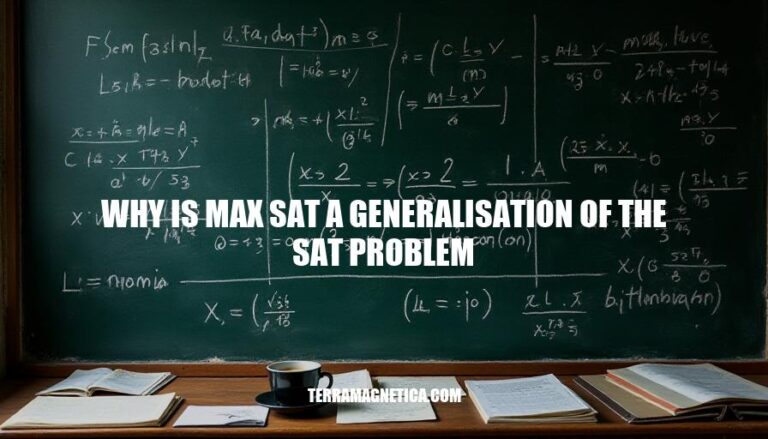


The Boolean satisfiability problem (SAT) is a fundamental problem in computer science. It involves determining if there exists an assignment of truth values to variables that makes a given Boolean formula true.
MAX-SAT is a generalization of the SAT problem. While SAT asks if there is an assignment that satisfies all clauses of a Boolean formula, MAX-SAT seeks the assignment that satisfies the maximum number of clauses. This makes MAX-SAT a broader and more flexible problem, applicable to optimization scenarios where not all constraints can be simultaneously satisfied.
The SAT problem (satisfiability problem) is a fundamental decision problem in computational complexity theory. It asks whether there exists an assignment of truth values to variables that makes a given Boolean formula true.
The SAT problem’s complexity and its ability to encode various other problems make it a cornerstone of computational complexity theory.
The maximum satisfiability problem (MAX-SAT) is an extension of the satisfiability problem (SAT). While SAT asks whether there exists an assignment of truth values to variables that makes all clauses of a Boolean formula true, MAX-SAT seeks to find an assignment that maximizes the number of satisfiable clauses in the formula. This means that even if not all clauses can be satisfied simultaneously, MAX-SAT aims to satisfy as many as possible.
SAT (Boolean Satisfiability Problem):
MAX-SAT (Maximum Satisfiability Problem):
Similarities:
Differences:
Generalization:
The Max-SAT problem, an optimization variant of the SAT (Satisfiability) problem, has several practical applications that highlight its broader utility:
Circuit Design and Debugging: Max-SAT is used to identify and correct faults in digital circuits. Unlike SAT, which only checks if a solution exists, Max-SAT can optimize the number of satisfied constraints, making it more effective for debugging complex circuits.
Bioinformatics: In protein alignment and other bioinformatics tasks, Max-SAT helps in finding the best possible alignment by maximizing the number of matched sequences, which is crucial for understanding biological functions.
Telecommunications: Frequency assignment problems in telecommunications can be modeled using Max-SAT. It ensures optimal use of frequencies while minimizing interference, which is more practical than just finding any feasible assignment.
Scheduling: Max-SAT is applied in scheduling problems, such as satellite scheduling, where it maximizes the number of scheduled tasks within given constraints, providing more efficient solutions compared to SAT.
Combinatorial Auctions: In electronic markets, Max-SAT is used to determine the optimal allocation of goods in combinatorial auctions, maximizing the total value of the allocated items.
These applications demonstrate that Max-SAT’s ability to handle optimization makes it more versatile and practical for real-world problems compared to the SAT problem, which only determines the existence of a solution.
MAX-SAT is a generalization of the SAT problem because it seeks to find an assignment that maximizes the number of satisfied clauses, whereas SAT only asks if there exists an assignment that makes all clauses true.
This means MAX-SAT can handle optimization scenarios where not all constraints can be simultaneously satisfied, making it more flexible and applicable to a broader range of problems than SAT.